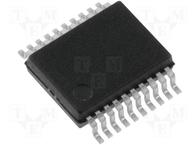下载

REV. 0
a
AN-564
APPLICATION NOTE
One Technology Way • P.O. Box 9106 • Norwood, MA 02062-9106 • Tel: 781/329-4700 • Fax: 781/326-8703 • www.analog.com
© Analog Devices, Inc., 2001
A Power Meter Reference Design Based on the ADE7756
By Stephen English and Dave Smith
INTRODUCTION
This application note describes a high-accuracy, low-cost
power meter based on the ADE7756. The design is for use
in the North American 3-wire/single-phase application.
This meter may also be used in a single-phase, 2-wire dis-
tribution system with a minimal amount of changes. The
reference design is comprised of the ADE7756, a micro-
controller, LCD display, serial interface, and power supply.
The ADE7756 is designed to interface to a microcontroller
through a serial interface (SPI). The SPI port allows the
user to calibrate various components of the meter,
including gain, offset, and phase errors. The purpose
of the microcontroller is to send display data to the LCD
and control the various functions of the meter. An
EEPROM is used to store various calibration param-
eters of the meter and store the meter’s data during a
power-down. The entire meter is calibrated through
an external calibration routine by a PC through an
external SPI interface.
The ADE7756 is comprised of two ADCs, a reference cir-
cuit, and all the signal processing necessary for the
calculation of real (active) power. Circuitry is provided to
null out various system errors including gain, phase,
and offset errors. Additional circuitry provides wave-
form sampling, programmable interrupts, and power
line monitoring. All registers of the ADE7756 are avail-
able through the SPI port. (See the ADE7756 data sheet
for their descriptions.) The data sheet provides detailed
information on the functionality of the ADE7756 and will
be referenced several times in this application note. This
application note should be used in conjunction with the
ADE7756 data sheet.
Design Goals
The goal for this meter is to comply with the ANSI C12.16
specifications. The reference design is for a single ele-
ment, Class 100 meter in a form 2S designation. This
designation complies with the wiring arrangements as
defined in ANSI C12.16-1991. Although the design in this
application is limited to the ANSI standard, the accuracies
achieved are well within the accuracy requirements of the
IEC1036 standards for a Class 1 meter. For reference, see
the section at the end of this application note, comparing
the IEC1036 and ANSI C12.16 standards. This section
explains the key IEC1036 specifications in terms of their
ANSI equivalents.
This design greatly exceeds the definition for many of
the accuracy requirements, e.g., accuracy at unity power
factor and at low (PF = ±0.5) power factor. In addition,
the dynamic range performance of the meter has been
extended to 500. The ANSI standard defines the maxi-
mum current of a Class 100 watt-hour meter as
100 amps with a reference current (I
REF
) of 15 amps. The
Accuracy Class is defined in Table I for both the Accu-
racy Class 0.5 and Class 0.2 static watt-hour meters. The
current range (dynamic range) for accuracy is specified
in terms of I
REF
.
Table I. Accuracy Requirements
Percentage Error Limits
3
Accuracy
Current Value
1
PF
2
Class 1 Class 0.5 Class 0.2
0.1 I
REF
≤ I < I
MAX
1 ±1.0% ±0.5% ±0.2%
1 Amp 1 ±2.0% ±1.0% ±0.4%
3 Amps 0.5 lag ±2.0% ±1.0% ±0.5%
50 Amps 0.5 lag ±2.0% ±0.6% ±0.3%
100 Amps 0.5 lag ±2.0% ±0.6% ±0.3%
NOTES
1
The current ranges for specified accuracy shown in Table I are
expressed in accordance with Load Performance Test, ANSI C12.20-
1998 Section 5.4.2.3, Table IV, in terms of the reference current.
2
Power Factor (PF) in Table I relates the phase relationship between the
fundamental (45 Hz to 65 Hz) voltage and current waveforms. PF in this
case can be simply defined as
PF = cos(f)
, where
f
is the phase angle
between pure sinusoidal current and voltage.
3
Accuracy Class is defined as the limits of the permissible percentage
error. The percentage error is defined as:
Percentage Error =
Energy Registered by Meter — True Energy
True Energy
100%×








